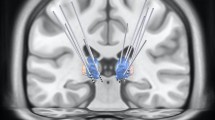Abstract
Deep brain stimulation (DBS) is a therapy that has been used for more than half a century to treat chronic pain. The first use of these treatments occurred in the 1950s when neurosurgeons stimulated the septal region nuclei in patients with psychiatric diseases who also suffered from chronic pain. Over the next 20 years, the therapy evolved to include the sensory thalamic nuclei to treat pain of neuropathic origin. Stimulation of the periventricular grey matter (PVG) has generally been recommended for the treatment of nociceptive pain, whereas the sensory thalamus (ST) remains the preferred stimulation site for neuropathic pain. Currently several new targets are under investigation. Outcomes for both facial and extremity pain have been positive with appropriate patient and target selection. The use of DBS in the neuromodulation algorithm is increasingly helpful to those who have severe pain. Because of its invasiveness and the risks associated with DBS, it is restricted to a selected group of patients in whom conservative treatment of chronic pain syndromes has been ineffective.
Access this chapter
Tax calculation will be finalised at checkout
Purchases are for personal use only
Similar content being viewed by others
References
Zrinzo L, Foltynie T, Limousin P, Hariz MI. Reducing hemorrhagic complications in functional neurosurgery: a large case series and systematic literature review. J Neurosurg. 2012;116:84–94.
Falowski S, Ooi YC, Smith A, Verhargen Metman L, Bakay RA. An evaluation of hardware and surgical complications with deep brain stimulation based on diagnosis and lead location. Stereotact Funct Neurosurg. 2012;90:173–80.
Baizabal Carvallo JF, Mostile G, Almaguer M, Davidson A, Simpson R, Jankovic J. Deep brain stimulation hardware complications in patients with movement disorders: risk factors and clinical correlations. Stereotact Funct Neurosurg. 2012;90:300–6.
Coley E, Farhadi R, Lewis S, Whittle IR. The incidence of seizures following deep brain stimulating electrode implantation for movement disorders, pain and psychiatric conditions. Br J Neurosurg. 2009;23:179–83.
Suggested Reading
Abosch A, Timmermann L, Bartley S, Rietkerk HG, Whiting D, Connolly PJ, et al. An international survey of deep brain stimulation procedural steps. Stereotact Funct Neurosurg. 2013;91(1):1–11.
Boccard SG, Pereira EA, Moir L, Aziz TZ, Green AL. Long-term outcomes of deep brain stimulation for neuropathic pain. Neurosurgery. 2013;72:221–30.
Hosobuchi Y. Dorsal periaqueductal gray matter stimulation in humans. Pacing Clin Electrophysiol. 1987;10:213–6.
Kumar K, Toth C, Nath RK. Deep brain stimulation for intractable pain: a 15-year experience. Neurosurgery. 1997;40:736–46.
Kumar K, Wyant GM, Nath R. Deep brain stimulation for control of intractable pain in humans, present and future: a ten-year follow-up. Neurosurgery. 1990;26:774–82.
Levy RM, Lamb S, Adams JE. Treatment of chronic pain by deep brain stimulation: long-term follow-up and review of the literature. Neurosurgery. 1987;21:885–93.
Pool JL, Clark WD, Hudson P, Lombardo M. Hypothalamic-hypophyseal interrelationships. Springfield: Charles C. Thomas; 1956.
Rinaldi PC, Young RF, Albe-Fessard D, Chodakiewitz J. Spontaneous neuronal hyperactivity in the medial and intralaminar thalamic nuclei of patients with deafferentation pain. J Neurosurg. 1991;74:415–21.
Author information
Authors and Affiliations
Corresponding author
Editor information
Editors and Affiliations
Rights and permissions
Copyright information
© 2016 Springer Science+Business Media New York
About this chapter
Cite this chapter
Lad, S.P., Petersen, E.A., Marky, A., Deer, T.R., Levy, R.M. (2016). Neurostimulation: Stimulation of the Cranium and Head: Stimulation of the Deep Brain for the Treatment of Chronic Pain. In: Deer, T., Pope, J. (eds) Atlas of Implantable Therapies for Pain Management. Springer, New York, NY. https://doi.org/10.1007/978-1-4939-2110-2_32
Download citation
DOI: https://doi.org/10.1007/978-1-4939-2110-2_32
Publisher Name: Springer, New York, NY
Print ISBN: 978-1-4939-2109-6
Online ISBN: 978-1-4939-2110-2
eBook Packages: MedicineMedicine (R0)




